




MARCH 2023 • Vol.10 • No.03 (ISSN 2564-1980) Themed Edition on Employee Financial Wellness HOW HR CAN HELP EMPLOYEES’ FINANCIAL WELL-BEING IN TIMES OF ECONOMIC UNCERTAINTY - Dinesh Sheth, Founder and CEO, Green Circle Life The State of Employee Financial Wellness 2023 Page 19 - 38 Sponsored by

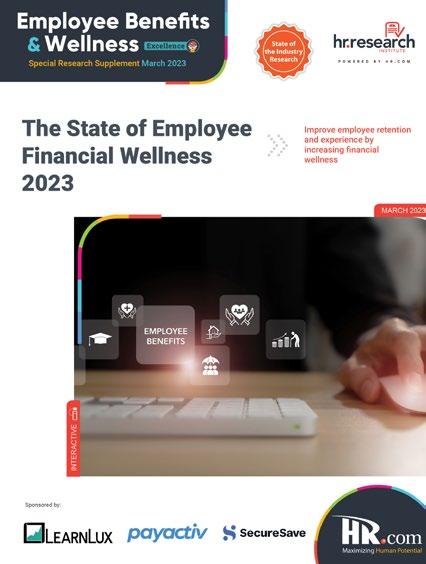
Articles How HR Can Help Employees’ Financial Well-Being In Times Of Economic Uncertainty The success of a financial well-being initiative depends on communication from HR leaders – Dinesh Sheth, Founder and CEO, Green Circle Life 07 On the Cover INDEX Employee Benefits & Wellness Excellence MARCH 2023 Vol.10 No.03 51 3 Tips To Better Manage Your Work-From-Home Teams Remote workforce challenges and how to overcome them – Monica Foster and Heather Johnson, Managing Directors, Focus Search Partners 55 The Pregnant Workers Fairness Act: What Employers Need To Know A guide to compliance and best practices for accommodating pregnant and postpartum workers – Jordi Romero, Co-Founder and CEO, Factorial (ISSN 2564-1980) 13 Fertility Coverage: A Benefit For Everyone Meeting evolving employee expectations – Dr. G. David Adamson, Founder, Chairman and CEO, ARC Fertility 44 How Managers Can Better Take Care Of Their Health A healthy boss creates a healthy workplace – Lacey Leone McLaughlin, President, LLM Consulting Group, Inc. Themed Edition on Employee Financial Wellness The State of Employee Financial Wellness 2023 Improve employee retention and experience by increasing financial wellness Page 19 - 38
How Is Your Financial Wellness Program
Stacking Up Against Your Employee’s Needs? Employers must measure the effectiveness of financial wellness programs to ensure support for all employees


- Assad Lazarus, Chief Client & Development Officer, Purchasing Power®
Top Picks 10 15
HR Professionals Support Digital Transformation And Virtual Care As Future Proof Opportunities
Why a coordinated approach to care is crucial for better outcomes
- Michael Gorton, CEO and Michael Brombach, COO, Recuro Health
39
ESAs And Retirement Accounts: Why Employees Need Both
Balancing short-term and long-term financial goals
- Devin Miller, CEO & Co-Founder, SecureSave
47
2023 Is The Year To Give Female Frontliners More Flexibility
A key to retention and productivity
- Sarah Moore, Chief Marketing Officer, Beekeeper
INDEX
How are our Employee Benefits & Wellness Products and Services helping
Benefits & Wellness Excellence - Monthly Interactive Learning Journal
This monthly interactive learning experience captures key metrics and actionable items and keeps you focused on your Benefits and Wellness planning goals and solutions.
Benefits and Wellness Virtual Events

Employee Benefits and Wellness Virtual Events ensure attendees stay compliant and up-to-date with the latest changes to employee benefits and wellness regulations. Each event varies on topics such as healthcare legislation and compliance related to employee benefits and workplace wellness programs including COBRA, FMLA, Medical Benefits, the Affordable Care Act (ACA), Outsourcing Benefits, Retirement Benefits, Voluntary Benefits and Work-Life Programs. Wellness topics encompass injury prevention, battling obesity, disease prevention, how technology is affecting wellness. Each Virtual Event consists of up to 10 credit webcasts.
Benefits and Wellness Webcasts for Credit

HR.com webcasts deliver the latest Benefits and Wellness industry news, research trends, best practices and case studies directly to your desktop. Webcasts are available live online with a downloadable podcast and a copy of the slides (PDF) available before and after each webcast. Earn all of the required recertification credits for aPHR, PHR, SPHR, GPHR, and SHRM Certifications. HR.com’s onehour webcasts, in every HR specialty including Benefits and Wellness, are pre-approved for HRCI and SHRM credit (excluding Demo webcasts).
Benefits and Wellness Community
Join more than 100,000 HR.com members with a similar interest and focus on Benefits or Wellness. Share content and download research reports, blogs, and articles, network, and “follow” peers and have them “follow” you in a social network platform to communicate regularly and stay on top of the latest updates. This well established Benefits and Wellness Communities are an invaluable resource for any HR professional or manager.
to make you smarter?
For more information phone: 1.877.472.6648 | email: sales@hr.com | www.hr.com
Use these invaluable Employee Benefits & Wellness resources today!
Editorial Purpose
Our mission is to promote personal and professional development based on constructive values, sound ethics, and timeless principles.
Excellence Publications
Debbie McGrath CEO, HR.com - Publisher
Sue Kelley Director (Product, Marketing, and Research)
Prioritizing Employee Financial Wellness: A Critical Part of Workplace Well-being
Financialwellness is an essential aspect of employee well-being that can significantly mitigate stress levels, boost productivity, and enhance job performance across the board. Unfortunately, many employees are struggling to make ends meet, living paycheck to paycheck and facing unexpected financial emergencies. As an employer, it's crucial to support your staff through these challenges and provide them with the resources they need to achieve financial wellness.
Employee Benefits & Wellness Excellence
Babitha Balakrishnan Editor

Nataraj Ramesh Design and Layout (Digital Magazine)
Chandra Shekar Magazine (Online Version)
Submissions & Correspondence
Please send any correspondence, articles, letters to the editor, and requests to reprint, republish, or excerpt articles to ePubEditors@hr.com
For customer service, or information on products and services, call 1-877-472-6648
For Advertising Opportunities, email: sales@hr.com
Employee Benefits & Wellness Excellence (ISSN 2564-1980)

is published monthly by HR.com Limited, 56 Malone Road, Jacksons Point, Ontario L0E 1L0
Internet Address: www.hr.com
Copyright © 2023 HR.com. No part of this publication may be reproduced or transmitted in any form without written permission from the publisher. Quotations must be credited.
One way to do this is by implementing an Employee Assistance Program that provides financial support and education to your employees. The success of such a program depends on communication from HR leaders, providing targeted communication for recurrent activities like financial planning, annual enrollment in benefits, employerprovided benefits information, repayment of loans, and easy access to financial education.
Pairing retirement accounts with resources like financial wellness support can improve employee well-being, productivity, and retention.
The March edition of Employee Benefits & Wellness Excellence includes articles that focus on financial wellness to help reduce financial stress and improve overall well-being. Additionally, the magazine explores the evolving employee expectations, including the demand for fertility treatment coverage and the need for leaders to prioritize their own mental health.
Also included is an exclusive research study by the HR Research Institute, The State of
Employee Financial Wellness 2023 that offers insights on workforce well-being and mental health support via employee financial wellness programs & retirement planning.
Dinesh Sheth's (Founder and CEO, Green Circle Life) article, How HR Can Help Employees' Financial Well-Bring In Times Of Economic Uncertainty, Devin Miller's (CEO & Co-Founder, SecureSave) article, ESAs And Retirement Accounts: Why Employees Need Both and Assad Lazarus' (Chief Client & Development Officer, Purchasing Power) How Is Your Financial Wellness Program Stacking Up Against Your Employee’s Needs? discuss the importance of financial wellness for employees and how it can benefit companies.
In conclusion, financial wellness is a journey that requires time and consistent effort, but the rewards are worth it. By providing your employees with the resources they need to achieve financial stability, you can improve their overall well-being and productivity, leading to a healthier and more productive workplace.
We trust that the articles featured in this edition are useful and informative, and we appreciate any feedback or suggestions that you may have.
Happy Reading!
Disclaimer: The views, information, or opinions expressed in the Excellence ePublications are solely those of the authors and do not necessarily represent those of HR.com and its employees. Under no circumstances shall HR.com or its partners or affiliates be responsible or liable for any indirect or incidental damages arising out of these opinions and content. EDITOR’S NOTE
Subscribe now for $99 / year And get this magazine delivered to your inbox every month Become a Member Today to get it FREE! SIGN UP OR
Babitha Balakrishnan and Deepa Damodaran Excellence Publications Managers and Editors
Team
Write to the Editor at ePubEditors@hr.com
Babitha Balakrishnan Editor, Employee Benefits & Wellness Excellence
Debbie Mcgrath Publisher, HR.com
In a world of unparalleled challenges (global pandemic, racial injustice, political rivalry, digital 4.0, emotional malaise), uncertainty reigns. Finding opportunity in this context requires harnessing uncertainty and harnessing starts with reliable, valid, timely, and useful information. The Excellence publications are a superb source of such information. The authors provide insights with impact that will guide thought and action.
Dave Ulrich

Excellence publications are my ‘go-to’ resource for contemporary and actionable information to improve leadership, engagement, results, and retention. Each edition offers rich and diverse perspectives for improving the employee experience and the workplace in general.


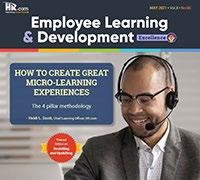
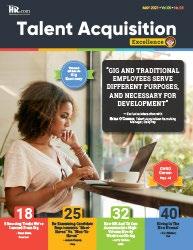
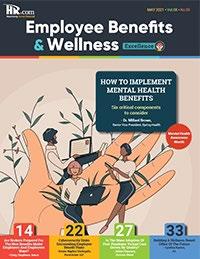
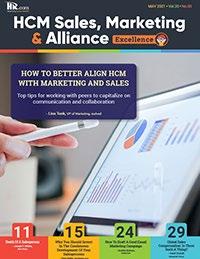


 Winkle
Winkle
I regularly read and contribute to Leadership Excellence and Talent Management Excellence. I use many of the articles I read to augment my own presentations and I often share the articles with my clients. They are always quick, right on target for the latest issues in my field, and appreciated by my clients. If you want to stay up to date on the latest HR trends, choose a few of the different issues from the Excellence series of publications.


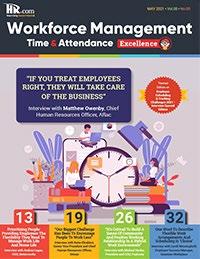
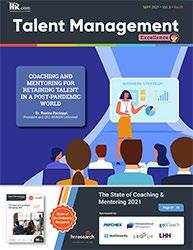
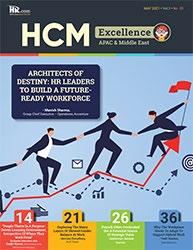
We’re eager to hear your feedback on our magazines. Let us know your thoughts at ePubEditors@hr.com
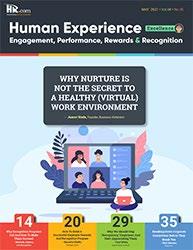 Rensis Likert Professor, Ross School of Business, University of Michigan Partner, The RBL Group
Rensis Likert Professor, Ross School of Business, University of Michigan Partner, The RBL Group
WHY EXCELLENCE PUBLICATIONS?
Julie
Giulioni Author, Virtual /Live Keynote Presenter, Inc.’s Top 100 Leadership Speakers
Dr. Beverly Kaye CEO, BevKaye&Co.
How HR Can Help Employees’ Financial Well-Being In Times Of Economic Uncertainty
By Dinesh Sheth, Green Circle Life
Prices for goods and services have increased due to the pandemic, the war in Ukraine, and ongoing supply shortages. This is known as inflation at its best. Since the summer of 2021, the Consumer Price Index (CPI) has measured incremental increases in the prices of consumer goods, most recently measuring 6.4% between January 2022 and January 2023. Federal agencies, such as the Federal Reserve, have begun the disinflationary process to quell inflation but employees continue to stretch their budgets to afford the necessities – food, housing and energy - while planning for unexpected road bumps.
Worker’s Financial Worries
To prepare for a potential recession, or the so-called soft-landing, employers and employees alike are cutting costs, paying off debts and seeking additional revenue streams, as well as assessing their financial situation to ensure they can prepare for the future.
Unfortunately, employees have limited options, if any, and many people are ill-equipped for an economic downturn: over two-thirds (39%) of workers have less than $1,000 in savings, according to a recent study Financial stress due to inflation is altering employees'
retirement savings and when employees plan to retire: 37% of workers report they tapped into their retirement accounts to make ends meet. Additionally, a recent survey found that more than half of women surveyed plan to delay their retirement due to inflation. Add the stress of paying off debt to the pile, and workers are not only struggling to reach their financial goals, such as owning property or starting a family, but this is impacting their overall well-being.
Start with a Self-Assessment
Achieving financial freedom during turbulent economic times is not only stressful but a challenging process as well. Employers already provide financial wellness benefits to help meet many of the financial needs of their employees. Some of the most common and impactful benefits include employer-sponsored retirement plans, insurance, encompassing health, life, disability, special education or legal assistance. However, employees may still feel anxious about the future – especially given the impact of inflation and a potential recession. Employees should have confidence in their finances, no matter the macroeconomic landscape.
Submit Your Articles Employee Benefits & Wellness Excellence presented by HR.com MARCH 2023 7 COVER ARTICLE
The success of a financial well-being initiative depends on communication from HR leaders
Before overhauling your benefits or health & wellness systems, perform a self-assessment and ask yourself:
● Do my employees know how to access and alter their 401(k) contributions?
● Do my employees know how to enroll in employer-sponsored insurance plans?
● Do they understand and enroll in a Health Savings Plan, if eligible?
● Is payroll, tax and insurance information readily available when needed?
● Can we share additional financial education resources through digital channels?
● Do I have a flexible, digital HR ecosystem to make necessary changes to improve their lives without having to hire more people in HR?
difference in your employees' financial well-being. HR leaders should communicate their benefits and education resources consistently to remind employees of the support they receive. Additionally, promoting financial education and planning resources that boost accessibility to your benefits through the mobile channel can encourage and improve their financial well-being.
Educate Your People
These questions are the baseline for HR departments, but these simple conditions can make a huge
Financial education is an important resource to share with your employees and their family members; something that many feel their employer should provide – 58% of Gen Z and 57% of Millennial workers believe their employer has a responsibility to help them feel more financially empowered. Today, there are infinite resources that explain retirement, 401(k)s, HSA, HRA, taxes and budgeting in eBooks, online courses, podcasts and even YouTube. Regardless of age or background, HR leaders should encourage employees to use the available financial education resources to learn and understand more about personal finance.
How HR Can Help Employees’ Financial Well-Being In Times Of Economic Uncertainty
Submit Your Articles Employee Benefits & Wellness Excellence presented by HR.com MARCH 2023 8
Also, benefits vendors – whether retirement, payroll, health savings or an insurance vendor – often create educational videos and FAQs for their users to help people make the most informed decisions about their future. HR leaders can easily upload or link these resources to their own website or mobile app as a simple step to educate their employees.
Consider Employee Apps
With the rise in smartphone usage and digital banking products, mobile banking is commonplace. Whether employees work from home, the office or a different work location, mobile apps are often the fastest and most convenient place to access and use financial information.
HR leaders can provide their own company branded mobile app with all their benefits, such as payroll, total rewards and especially financial education resources. Employees can quickly access all relevant information regarding their financial benefits and have their queries answered - a relief when considering the time sensitivity and weight of financial planning. Also, as we know, many benefits are decided and used by an employee’s family. Creating a mobile access point for family members’ benefits can relieve employees of the pressure to disseminate company benefits, services and information.
Address the Stress
Learning to budget is not an easy task. Employees are overwhelmed by their financial situations, so much so that their anxiety is hurting their overall health and productivity. According to a recent report, a third of women surveyed are experiencing physical and mental impacts of stress due to their financial situations.
That said, establishing an environment where staff can de-stress, whether by encouraging physical activity, mental health counseling or anonymously asking employees to share their biggest HR needs, can help improve their psychological and physical well-being.
Consistency
Planning is more difficult than ever, given the current economic challenges. Employers and employees alike are probably seeking a "silver bullet" solution to their financial needs. However, it takes time and consistent effort to achieve financial goals. Also, when company financial resources are limited and new, expensive financial benefits are out of reach for your HR budget, finding ways to optimize your existing digital HR ecosystem is the right step.
Ultimately, the success of a financial well-being initiative depends on communication from HR leaders. Targeted communication for recurrent activities like financial planning, annual enrollment in benefits, employer-provided benefits information, repayment of loans as well as providing easy access to financial education could give employees a hand in their busy lives.
 Dinesh Sheth is the Founder and CEO of Green Circle Life
Dinesh Sheth is the Founder and CEO of Green Circle Life
Would you like to comment?

How HR Can Help Employees’ Financial Well-Being In Times Of Economic Uncertainty
Submit Your Articles Employee Benefits & Wellness Excellence presented by HR.com MARCH 2023 9
How Is Your Financial Wellness Program Stacking Up Against Your Employee’s Needs?

Employers must measure the effectiveness of financial wellness programs to ensure support for all employees
By Assad Lazarus, Purchasing Power
Financial wellness is not a destination. It’s a journey. And a very challenging one for so many in our society. Unfortunately, today’s ongoing economic uncertainty is causing unexpected
roadblocks for some and exacerbating longstanding issues for others.
As cited in Purchasing Power’s State of Employee Finances
report, more than half of full-time employees were either unable to cover monthly living expenses or lived paycheck to paycheck.
TOP PICK Submit Your Articles Employee Benefits & Wellness Excellence presented by HR.com MARCH 2023 10
Surprisingly, this isn’t exclusive to low-income earners.
In fact, one 2022 survey found that 64% of employees with an annual household income greater than $100,000 lived paycheck to paycheck. That same income group said they were struggling to keep up with monthly bills, up 16% from 11% the previous year.
The result is continued blurred lines when it comes to financial wellness. Higher income households still living paycheck to paycheck is reducing the number of thrivers in the American workforce, or those living comfortably with money saved for emergencies and retirement.
Instead, more employees are operating more as survivors –comfortable for long-term, but ill-prepared for an emergency – and even more as strugglers, having trouble meeting their day-to-day financial needs.
To address the need for greater financial support and to circumvent the economy’s impact on employee’s day-to-day lives, employers must recognize the situation and, more importantly, take action. In fact, nearly 9 in 10 employees expect their employer to offer access to financial support and resources.
The Immediate Need
Traditionally, employers provide only long-term focused financial wellness solutions like 401k and healthcare saving accounts (HSAs). While these are great for thrivers, the paycheck-to-paycheck population aren’t as able to or equipped to afford or take advantage of these offerings.
Employers must therefore seek to provide a comprehensive and inclusive suite of benefits that include immediate financial wellness solutions. These solutions can include employee purchasing programs, earned wage access (EWA), financial
coaching, and more. And many of these are available to employers and employees at no cost.
While pursuing a financially effective and inclusive financial wellness program is critical to being an employer of choice, it requires commitment and planning. It is important to profile and identify the needs of the workforce and understand the types of support they need. Employers must seek to meet employees where they are and they must then act and implement such programs.
Then, employers must communicate the programs via channels that reach all employees, like newsletters, flyers, or in face-to-face meetings. If employees aren’t educated on the programs available or are hesitant to participate in the programs because of confusion around how they work, the programs won’t be effective.
Lastly, employers must measure the impact of the programs.
Measuring Financial Wellness
No matter how great a financial wellness program is perceived to be by the employers designing them, they are not a “build it and they will come” type of initiative. Rather, these programs need to be regularly evaluated and adjusted to meet employee’s changing needs, allow for program refinement, and to prove to the workforce that their employers are listening.
How Is Your Financial Wellness Program Stacking Up Against Your Employee’s Needs?
Submit Your Articles Employee Benefits & Wellness Excellence presented by HR.com MARCH 2023 11
Start with Objectives
To best measure the effectiveness, employers should first define the program’s objectives. Start by asking a few questions, such as:
● What do you want a financial wellness solution (or solutions) to do?
● What solution would work best for your workforce?
● Are your employees dispersed or concentrated in a single area?
● What are you currently offering? What does your approach to wellness look like – mental, physical, and financial?
● Do your current providers offer financial wellness solutions? Are they helpful for low- and middle-income earners?
With a full-picture understanding of a program’s capabilities and the needs of the company’s workforce, clear quantitative and qualitative objectives can be set and monitored.
Identify the Right Data
Quantitative metrics can be gathered and monitored through several methods. First, registration or enrollment into the offered programs should be regularly monitored, and if it’s lower than desired, take a closer look to understand if it’s because of a lack of communication about the offering or if it’s a lack of need.
Enrollment, participation, and contributions in long-term programs should be monitored, too, and tracked against participation in the offerings focused on immediate support.
Employers can also gather insights through a regular employee survey to take a pulse on their financial wellness and outlook for the coming quarter or year. And, of course, metrics like absenteeism, turnover, and productivity should also be measured to identify the extent of how financial wellness – or lack thereof – is taking a direct toll on the workforce.

From a qualitative perspective, regular check-ins and conversations about the impact of these solutions will give employers direct insight into what is and is not working. Having these open conversations give employees the opportunity to be heard and have their situations understood.
Report Regularly
Once these insights have been gathered and conversations have been had about the effectiveness of inclusive financial wellness programs, employers should report on this internally.
Select a cadence that makes the most sense for the organization, whether that be annually, bi-annually, or quarterly, and share stats like change in stress levels or impacts to productivity and turnover. Show employees that the company is listening
and acting, that the offerings are having a positive impact and that the employees are not alone in their struggles because everyone is benefiting.
It's Not Too Late to Get Started
Many companies may already be offering immediate financial wellness solutions, some may just be getting started and some may not have considered it yet. Regardless of where a company is on this journey, it’s not too late to get started or to keep improving.
The process doesn’t have to be complicated. Simply talk to employees and understand what they need. Identify and implement the solutions needed, tapping third party organizations for help as needed. And empower employees in their personal financial wellness journeys.
Assad Lazarus is Chief Client & Development Officer at Purchasing Power®. In this capacity, he oversees all operational and strategic activities representing the spectrum of business products and services for the company’s client base.
Would you like to comment?
How Is Your Financial Wellness Program Stacking Up Against Your Employee’s Needs? Submit Your Articles Employee Benefits & Wellness Excellence presented by HR.com MARCH 2023 12
Fertility Coverage: A Benefit For Everyone
Meeting evolving employee expectations
By Dr. G. David Adamson, ARC Fertility
Benefits professionals understand better than just about anyone else how important it is to keep up with the times. Employee expectations are constantly evolving, and a benefit that is seen as niche (or even unheard of) may become a necessity if companies hope to attract and retain the top talent. Just three years ago, telecommuting was seen as a luxury for most employees, but after Covid, many employees aren’t willing to go back to a full-time in-office mode of work.
This evolution of employee expectations is especially true in the case of fertility treatment. Once seen as a private matter - and even stigmatized in the workplace - support to help employees form and grow their families was not seen as a benefit that employers should provide. Not only did many companies not fully understand their opportunity to help employees expand their families, but benefits professionals also worried that requiring such coverage might actually drive up their own healthcare costs.

Submit Your Articles Employee Benefits & Wellness Excellence presented by HR.com MARCH 2023 13
Even as some workplaces began offering fertility coverage, these benefits were only extended to married female employees or the wives of male employees. Help was often not available to single mothers, single fathers, same sex couples, or others outside the so-called “traditional” family unit. Yet without access to the same benefits as everyone else, talented employees in these categories can be difficult to recruit and retain.

Thankfully, changing employee expectations, the adaptability of benefits teams, and the ingenuity of fertility healthcare providers have now made family-forming benefits more widely available. As the conversation about employee healthcare has shifted, benefits such as fertility treatments have become more common with progressive companies looking to hire and retain the best talent they can. These employers acknowledge work-life balance as a premium and inseparable part of a comprehensive benefits package. In many cases, employees whose workplaces do not provide the benefits they need to start a family may look for other employers who do.
This has inspired benefits professionals to find creative ways to incorporate fertility treatments into competitive benefits packages, as well as to broaden the way they think about these programs. For example, in-vitro fertilization (IVF) and egg-freezing were once the primary fertility treatments available.
While important, these procedures do not meet the needs of cisgendered males with fertility challenges, some trans patients, or male same-sex couples. Even then, company insurance policies can sometimes deny coverage for such procedures without proof of an infertility diagnosis, resulting in some employees not getting the care they need.
The need for reasonable costs both for the individual employee and company remains a major factor when selecting fertility coverage programs. Benefits teams are best advised to choose a fertility care program that is modular and activates on a per-employee use basis. In programs like this, the company only pays for those benefits used by individual employees based on their family-forming needs, rather than adding to their overall insurance costs.
Today’s top employees demand a company culture that cares about more than just the work they do. By remaining flexible and considering the needs of employees, benefits teams can ensure they hire and retain the best staff, while conveying to their entire workforce how important their families are to the organization.
Would you like to comment?

Fertility Coverage: A Benefit For Everyone
G. David Adamson MD, FRCSC, FACOG, FACS, is the Founder, Chairman and CEO of ARC Fertility. He is a globally recognized reproductive endocrinologist and surgeon, and is a Clinical Professor, ACF at Stanford University, and Associate Clinical Professor at UCSF. Dr. Adamson also serves as the current Chair of the International Committee Monitoring ART (ICMART), a WHO NSA/NGO.
Submit Your Articles Employee Benefits & Wellness Excellence presented by HR.com MARCH 2023 14
HR Professionals Support Digital Transformation And Virtual Care As Future Proof Opportunities
Why a coordinated approach to care is crucial for better outcomes
By Michael Gorton, and Michael Brombach, Recuro Health
As the pandemic taught us to more efficiently work from anywhere, it also created circumstance where medical delivery focused on location of the patient, rather than the provider. With mounting pressures to design and implement health benefits programs that meet the needs of geographically and culturally diverse populations, HR professionals increasingly turn to digital solutions with capabilities to deliver a more personalized approach. Now recognized as telehealth or virtual care, this remarkable technology is the channel for providing patient-centric, on-demand care. The next generation to this digital solution is focused on preventative health and wellness.
Throughout the healthcare ecosystem, industry leaders recognize virtual care as ‘future proof” because it leverages the most advanced information technologies and digital health innovations to realize new and emerging value opportunities. As a solution strategy, integrated virtual care applications are successfully meeting today’s challenges in complex clinical, economic and workforce environments.
● Addressing healthcare needs of an exploding population coupled with a shortage of primary care physicians and scarcity of behavioral health clinicians
● Responding to the demand for more affordable and convenient access
● Resolving patient barriers to accessing care, issues associated with health equity
● Realizing time and cost efficiencies, reducing hospital, payer and patient expenses
● Improving overall experience of healthcare and outcomes
Nearly three-quarters (74%) of the 135 large employers surveyed by the Business Group on Health said virtual care will have a major impact on care delivery in the future. With greater adoption and acceptance of virtual care, HR decision-makers welcome opportunities to reshape the design of employer-sponsored health plans and include digital care options. What is most appealing for companies of all sizes is access to a one-stop resource that integrates all their vendor solutions in one central location for a “complete care” experience.
TOP PICK Submit Your Articles Employee Benefits & Wellness Excellence presented by HR.com MARCH 2023 15
Bringing together the best of preventative care, with a coordinated model that includes primary care and behavioral health, select virtual care solutions are designed to improve health outcomes, reduce medical spending and deliver top-tier member satisfaction.
Virtual care solutions can be scaled to the size and needs of the employee population, customized from a suite of integrated digital health. On-demand access to in-demand health services is enabled in real-time through computing and mobile technologies across multiple communication channels. This capability provides a seamless, single point experience, delivering health services whenever care is needed and wherever the patient is located. By removing the boundaries of a physician office visit, or making hybrid virtual and physical arrangements available, virtual care provides greater access tied to convenience and affordability compared to in-person visits.
For human resource executives and benefit administrators, a “virtual first” strategy optimizes health plan performance and enhances employee engagement and experience. This can lead to an organization-wide change focused on catching medical issues before they become expensive and dangerous,
Virtual Primary Care Transforms Healthcare Access, Delivery and Utilization
The introduction of Virtual Primary Care (VPC) is dramatically reshaping how healthcare is accessed, delivered and utilized. Connecting employee health plan participants and their dependents with virtual providers through a virtual-first approach to primary care is proving to positively impact the triad of cost, quality and access to care with an added benefit of employee satisfaction with benefits.
A well-designed VPC solution provides employees with convenient access to a top primary care physician (PCP) of their choosing, Because as studies claim, one in three millennials do not have a relationship with a PCP and are less likely to seek preventative care on a regular basis, VPC is especially important as a solution to generational healthcare needs. The virtual solution is effective because it combines simplicity with the ability to catch things early on. As Ben Franklin has said: “an ounce of prevention is worth a pound of cure.”
HR Professionals Support Digital Transformation And Virtual Care As Future Proof Opportunities
Submit Your Articles Employee Benefits & Wellness Excellence presented by HR.com MARCH 2023 16
A designated VPC physician provides routine health and wellness screenings and preventative care along the employee’s healthcare journey – and refer patients to the appropriate specialists. VPC can also cover access to comprehensive risk assessments that cover physical and behavioral health treatments.
One caveat: many HR administrators embrace narrow provider networks since they perceive opportunities for better quality and cost savings. With optimized VPC models, changing networks may not be an issue since they do not force participants to identify a new primary care physician and reestablish a personal, dedicated relationship.
Genomics will Play a Significant Role in Virtual Primary Care
As part of an uptick in virtual primary care adoption, integrated genomics will become a significant disruptive force and value proposition differentiator as an integrated benefit. The ability to transform genomic information into effective diagnostics and therapies with greater precision represents the future of personalized and preventative medicine as it embraces genomic tools to enable more precise prediction and treatment of disease.
The fundamentals of genomics will require the development, standardization and integration of several important tools into health systems and clinical workflows. These genetic tools include health risk assessment, family health history, clinical decision support for complex risk and predictive information.
Together with in-home diagnostics, genomic information and the efficacious application of Artificial Intelligence (AI) tools will enable a paradigm shift to a comprehensive approach. It will be possible to identify individual risks and guide clinical management and clinical decision making -- all of which form the basis for a more informed and effective approach to patient care.
A New Breed of Virtual Care Aligned with Coordinated Care
With healthcare and workplaces facing a pivotal moment of digital transition, integrated virtual care is poised for higher utilization and significant growth, as well as refinement. There is becoming greater emphasis on “care coordination” and diminished focus on siloed, add-on remote monitoring solutions that simply mirror the fragmentation and unreliable care transitions of the existing system.
HR Professionals Support Digital Transformation And Virtual Care As Future Proof Opportunities Submit Your Articles Employee Benefits & Wellness Excellence presented by HR.com MARCH 2023 17
Care coordination is a natural extension of the remote care model that integrates both digital and virtual care. It accesses healthcare services in a cogent way that dives better outcomes and provides a new moniker for the ‘care gatekeeper,’ such as a patient’s virtual primary care physician. Integrated into one central platform, comprehensive “complete care” services include virtual primary and urgent care, behavioral health, at-home lab testing, genomics testing, as well as a suite of supplemental benefits, such as chronic care management, pharmacy and care navigation.
What’s New, Next and Beyond
This next generation of virtual care is part of a greater seismic shift toward delivering the full spectrum of care wherever patients are located, whether at home or in the workplace. With the Digital Medical Home, patient data and records are securely stored and accessible by any provider, anytime, anywhere. It is an objective that is both consumer and payer centric, serving the care access needs of employees and all segments of the healthcare ecosystem. Continued advancements in wireless communications and data technologies are enabling remote patient screenings and diagnostics in a way not previously thought possible – and forging a digitally connected
relationship between patients and providers by way of virtual care.
As virtual care becomes more accessible, HR professionals can look forward to increased coverage by insurance companies and Plan Sponsors. Cost reduction and affordability will be significant drivers of virtual-first adoption. Today, several insurance products—such as this Kaiser Permanente plan— cover all virtual and telehealth services in a "virtual first" format.
Telehealth, VPC and the Digital Medical Home will begin to ameliorate concerns about rising healthcare costs by improving access to mental health services as well as primary care, genomics and labs.


The goal is to build and operationalize an entirely new engine that improves upon the virtual care model with the next generation of digital health innovation. The best tech-enabled telemedicine engine is founded on the principle to prevent first and treat when necessary. Given its current popularity and progress, virtual care will increasingly demonstrate its value and scalability to become the preferred healthcare delivery method for providing employee healthcare.
Michael Brombach is a contributing author to The Digital Medical Home and has published multiple thought leadership articles on topics including, how to solve healthcare’s complexity, future applications of virtual care models, the growth potential of consumerism in health care, and provider transformation. As Chief Operating Officer of Recuro Health , he leads strategy and development of Recuro’s digital health platform and products, overseeing integration, go-to-market strategy, and future product innovation.
Michael Gorton is a quintessential entrepreneur and company builder. As CEO of Recuro Health he leads a team which includes several leaders from Teladoc, where he served as the founding CEO and pioneered an industry-changing health care model that created a new efficiency paradigm in healthcare. Gorton co-authored and published The Digital Medical Home : a compendium of stories, personal anecdotes and true accounts of how telemedicine was born and how it grew into the industry we know today.
Would you like to comment?
HR Professionals Support Digital Transformation And Virtual Care As Future Proof Opportunities Submit Your Articles Employee Benefits & Wellness Excellence presented by HR.com MARCH 2023 18




Sponsored by: Improve employee retention and experience by increasing financial wellness
State of Employee Financial Wellness 2023 Special Research Supplement March 2023 INTERACTIVE MARCH 2023
The
ARTICLE
21
The State of Employee Financial Wellness 2023
Improve employee retention and experience by increasing financial wellness
30
How to Support Employee Financial Wellbeing Through
Turbulent Economic Times
By Brin Chartier, Director of Marketing, LearnLux




The Economic Imperative For Providing Financial Wellness Benefits
By Safwan Shah, CEO, Payactiv


What Kind of Company Needs an Employer-Sponsored ESA? 32
The HR Research Institute, powered by HR.com, the world’s largest social network for Human Resources professionals, is a key part of our mandate to inform and educate today’s HR professionals. Over the past three years, the HR Research Institute has produced more than 85 exclusive primary research and state of the industry reports, along with corresponding infographics in many cases, based on the surveys of thousands of HR professionals. Each research report highlights current HR trends, benchmarks, and industry best practices. HR Research Institute Reports and Infographics are available online, and always free, at www.hr.com/ featuredresearch
RESEARCH REPORT SUMMARY
23
by: Sponsored by: INDEX 20 RESEARCH REPORT SUMMARY
Survey conducted
26
STATE OF THE INDUSTRY RESEARCH
The State of Employee Financial Wellness 2023
Improve employee retention and experience by increasing financial wellness
Exclusive Study By The HR Research Institute


In the U.S., employees often struggle to make ends meet. In fact, nearly two-thirds of Americans are living paycheck to paycheck.1

The recent spikes in inflation since 2020 have made employees’ financial struggles worse. It seems everything has gone up in price: housing costs, groceries, gas, general goods and more. Meanwhile, wages have not kept up with inflation in most industries, so that real wages have declined in 80% of the private workforce.2
Key Findings
● Organizations have a long way to go when it comes to understanding and supporting their employees’ financial needs.
● Fewer than half of organizations currently have an employee financial wellness program/initiative or are thinking about implementing one.
● Most believe educating employees on financial issues potentially plays a key role in their wellness.
To better understand the current landscape of employee financial wellness, The HR Research Institute conducted an exclusive study of HR professionals entitled The State of Employee Financial Wellness 2023. The report covers the prevalence of financial wellness programs, the top sources of financial stress, the metrics that organizations track to measure the success of their initiatives, and much more.
● Organizations most commonly track a variety of metrics to measure the success of their financial wellness initiatives.
● Companies that successfully help their employees attain financial wellness to a high degree tend to do things differently from those that do not.
21 RESEARCH REPORT SUMMARY STATE OF THE INDUSTRY RESEARCH
Understanding Employees Financial Well-being
Only one-tenth of HR professionals surveyed say they understand the financial well-being
of employees in their organization to a great extent, based on solid investigations and metrics. Forty-four percent, however, say they somewhat understand employee financial wellness, basing their opinions on “sporadic data.”
Survey Question: To what degree does your organization organization?
To
being of employees to a great extent, based on solid investigations and metrics
0 10 20 30 40 50 16% 29% 44% 11% Not at all A little, based on a "gut feeling" Somewhat, based on sporadic data
a great extent, based on solid investigations and metrics
22 RESEARCH REPORT SUMMARY STATE OF THE INDUSTRY RESEARCH
We asked respondents to identify their employees' top five sources of financial stress. Inflation issues are at the top of the list, with 62% citing this source, the only response selected by more than half of respondents. The increases in interest rates, which especially impact costs of purchasing new housing, are also a common concern, cited by 42% of respondents. It’s no surprise then that the third most common source of financial stress is not earning enough money to pay bills and pay off debt (40%).
The Prevalence of Financial Wellness Programs

About one-quarter of organizations have a program/initiative to improve employee financial wellness, and about one-fifth are either currently in the process of implementing one or are in the planning stages. More than half currently do not have a program that is implemented or in the works. This could explain why so few organizations
successfully help employees with their financial well-being. However, of these, 23% say it’s something they would consider over the next 12 months and 12% say they would consider it in the next 5 years.
We asked respondents why they decided to implement financial wellness programs. Among those organizations that have embraced—or plan to implement—such programs, five key reasons stand out:
● to improve employee mental health
● to become an employer of choice
● to improve retention
● to help employees make decisions free of financial stressors
● to engage existing employees
23 RESEARCH REPORT SUMMARY STATE OF THE INDUSTRY RESEARCH
Improve employee mental health
Become an employer of choice (for recruitment purposes)
Improve retention
Help employees make decisions free of financial stressors
Engage existing employees
It's the ethical thing to do
Improve morale
Survey Question: organization has, or is planning to implement, an initiative to have implemented initiative because it is the ethical thing to do
Increase performance/productivity
Improve return on investment of benefits program
Improve quality of work
Improve interpersonal relationships and collaboration
Lower absenteeism
We asked respondents who said their organization does not have financial wellness initiatives why this is the case. Of the organizations that do not currently offer financial wellness initiatives, about half (45%) say it is because they have more important priorities.
Measuring the Success of Financial Wellness Programs
Cost is a major factor for organizations deciding to implement a financial wellness program, so how do organizations ensure they are getting a good return on investment once implemented?
16 0 10 20 30 40 50 60 57% 56% 50% 50% 44% 42% 38% 32% 19% 17% 17% 5%
24 RESEARCH REPORT SUMMARY STATE OF THE INDUSTRY RESEARCH
The most common metrics that organizations track and measure are:
● Employee attitudes at work (job satisfaction, morale, happiness)
● Enrollment and contributions to retirement plans, Health Savings Account (HSAs), etc.
● Reduction in employee turnover
● Employees’ satisfaction with the financial wellness program
● Worker engagement
The Current Benefits Landscape
A large majority of respondents say their organizations offer medical/dental insurance (87%) and life insurance (80%) as part of their benefits programs. Two-thirds also offer employee assistance programs (67%) and over half offer disability income insurance (59%).
Notes
1 Dickler, J. (2022, October 24). 63% of Americans are living paycheck to paycheck - including nearly half of sixfigure earners. CNBC. Retrieved from https://www.cnbc. com/2022/10/24/more-americans-live-paycheck-to-paycheckas-inflation-outpaces-income.html
2 Dynan, K., & Powell III, W. (2022, December 6). Wages in most US industries are not keeping up with inflation. PIIE. Retrieved from https://www.piie.com/research/piie-charts/wages-mostus-industries-are-not-keeping-inflation
To learn more about employee financial wellness in today’s organizations and for key takeaways and recommendations on the topic, check out the full report.

While 70% offer employer retirement plan contributions, fewer offer other financial-related benefits, such as HSAs/Health Reimbursement Arrangements (HRAs) contributions (50%), education spending reimbursement programs (42%), pension plans (27%) or stock options/equity (20%).
And, although respondents say childcare expenses is one of the top five sources of financial stress, just 9% of organizations offer childcare or dependent care vouchers or support.
State of
THE REPORT
Exclusive HR.com Research The
Employee Financial Wellness 2023 READ
25 RESEARCH REPORT SUMMARY STATE OF THE INDUSTRY RESEARCH
How to Support Employee Financial Wellbeing Through Turbulent Economic Times
Brin Chartier, LearnLux

This past year set a new standard for how financially tumultuous our world can be. With inflation topping over 8%, a chaotic home-buying market, job insecurity, volatility in stocks and bonds, the rise and fall of cryptocurrencies, and other financial pressures, employees at all income levels are experiencing heightened financial stress.
Team members who were already living paycheck to paycheck, struggling to pay off credit cards and student loans, and falling behind on retirement savings may be distracted on the job, miss work, experience mental health issues, or even switch jobs to add a few more dollars to their paychecks.
to free, unlimited guidance from fiduciary Certified Financial Planner™ professionals can help reduce financial worries, provide perspective, address any current financial crises, and make a plan to build for the future.
Helpful guidance for employees of all income levels during a market downturn
In turbulent times, financial wellbeing support for employees is an essential component of any benefits and employee wellness plan. Here are some helpful pieces of guidance you can pass along to your team.
Market changes are normal
For employers, this means higher turnover, reduced productivity, increased medical costs, more 401(k) loans and hardship withdrawals, more wage garnishments, and more employees taking on side hustles and second jobs or asking for raises to make ends meet.
A holistic, accessible financial wellbeing program provides support and a much-needed safety net to help employees whether these storms. Providing employees with digital tools, simple, jargon-free financial education, and direct access
Employees may be stressed as they watch the value fluctuate in their 401(k) or other investment accounts. That can be scary and frustrating, especially on top of rising prices for almost everything. LearnLux Certified Financial Planner™ professionals offer reassuring guidance that market changes are normal. Over the years, the market has had many ups and downs, such as when the internet bubble burst in 2001, during the 2008 Financial Crisis, and when businesses were shut down in 2020 due to the COVID-19 pandemic. Market changes are normal, and sticking to a longterm strategy is paramount.
26 STATE OF THE INDUSTRY RESEARCH
Market downturns Don’t usually last very long
The longest that the market has ever been down more than 20% (a “bear market”) was 2.7 years during the great depression, but on average bear markets last only 9.6 months.
It’s the long-term that matters
Historically, after every downturn, the market has always come back up. The S&P 500 index (a good indicator of market performance) has averaged gains of 10.5% per year from 1957 through 2021. (Investopedia)
Stay true to the plan
Employees may be thinking about selling their investments now and holding them in cash so that they won’t lose any more value. It's important to note that shares sold now could lose out on potential future growth if the market goes back up.
Even out risk with dollar-cost averaging

While a bear market may be a great time to take advantage of lower prices, dollar-cost averaging is the recommended long-term strategy. Dollar-cost averaging is the practice of investing a fixed dollar amount on a regular basis, regardless of the share price.

27 STATE OF THE INDUSTRY RESEARCH
How employees can take action during a market downturn
During economic downturns, employees seek trusted guidance and the tools they need to take action. Here are a few ways that team members can feel empowered about their financial situation during turbulent times.
Make or review their budget
With inflation at over 8% and gas prices soaring, it can be hard to make ends meet. Reviewing your budget and making any needed adjustments to your spending is the best way to stay ahead of the game and avoid drawing on your emergency savings or building up credit card debt when money is tight. For example, LearnLux members can review changes to their cashflow in real-time with the net worth and transaction insights feature and balance budget projections with the interactive budgeting tool.
Educate themselves about their investments
Employees with access to LearnLux can explore investing lessons to understand their options and ensure their investments match their desired risk level and time horizon.

Sign up for accessible FAQ events on inflation & the economy
During market downturns, LearnLux Certified Financial Planner™ professionals host special events to answer employee questions in real time. Information is presented in an accessible and jargon-free way for employees of all levels of financial confidence.
Speak with a trusted financial planner
Employees can easily book one-on-one calls with a trusted expert if they are worried and aren’t sure what to do next. A fiduciary financial planner can help them review their situation and make a plan, bringing peace of mind during these challenging times.
Remember, market fluctuations are normal. Employees should think long-term about their investments and consider making short-term adjustments to their spending. With helpful guidance from their employer and a trusted financial wellbeing program, they can be prepared for what’s to come.
Brin Chartier is the Director of Marketing at LearnLux, the leading provider of trusted financial wellbeing for the workplace. Brin is passionate about creating a world where having a financial plan is never out of reach. At LearnLux, she creates strategic content and marketing campaigns to support clients, partners, and members. Brin is based in Austin, TX, and in her free time volunteers as a marketing mentor, likes to do yoga, hike the Greenbelt, and is constantly counting the days until SXSW.
Would you like to comment?

28 STATE OF THE INDUSTRY RESEARCH
Trusted financial wellbeing for your entire workforce


Digital tools | Interactive education | 1:1 guidance from Certified Financial Planner™ professionals
Creating a world where having a financial plan is never out of reach.
LearnLux provides the most accessible and equitable global financial wellbeing program to empower anyone to have access to fiduciary financial guidance.
Unbiased
Fiduciary guidance that’s always in employees’ best interest.
Configurable
Customized for each employer, personalized for every employee.
Holistic
Meet the diverse needs of your workforce in all phases of life.
Global

US and global program parity with localized digital tools, interactive education, and local financial experts
We Never
Sell products or data
Make referral commissions


Surprise you with hidden fees

The Learnlux experience:



Guidance from Certified Financial Planner™ Professionals
Digital planning and financial tools


Interactive and personalized content


Benefits education and total rewards tools

Robust reporting shares outcomes and strategic insights

See LearnLux in action. Request a demo at learnlux.com
Proud Partner
The Economic Imperative For Providing Financial Wellness Benefits
Safwan Shah, CEO of Payactiv

In recent years, US employers have experienced a significant shift in their attitudes towards employee financial wellness. Today, 62% of employers feel that they are extremely responsible for employee financial wellness. In 2013, that number was only 13%, and 41% of employers felt they were somewhat responsible for their employees' financial health; by 2022, that figure had skyrocketed to an astonishing 97%.


This tremendous shift in business attitudes toward financial wellness has a credible foundation. The leading US employers like Walmart, Costco, Whole Foods, and many others have already seen measurable improvements in their recruitment, retention, and engagement metrics by making financial wellness a big part of their workplace culture.
3. Retention: Quitting a job becomes that much harder when financial wellness benefits are offered.

It is not surprising that there is a higher ROI when employees feel their employer cares about them. People react most favorably when they feel that their employer has their back. With over 100 million Americans living paycheck to paycheck, a company that offers financial wellness benefits and isn't afraid to talk about financial difficulties tends to win over the respect and admiration of its staff.
Here are three ways that organizations benefit from financial wellness programs in the workplace:
1. Loyalty: Employees feel the employer ‘genuinely’ cares and understands their needs and priorities.
2. Recruitment: With plenty of gig and freelance opportunities, employer sponsored financial wellness benefits help a candidate choose one employer over another.

30 STATE OF THE INDUSTRY RESEARCH
A recent Bank of America study shows that employees respond positively when they believe their employer genuinely cares about their financial wellness. As a result, businesses can see a return on investment of up to 50% in productivity, 43% in reduced stress, 41% in improved morale, and 36% increase in innovation.

As a result, it should come as no surprise that businesses across the United States are adopting financial wellness perks as a best practice to offer during recruitment. Originally offered by huge corporations such as Walmart, EWA is now accessible to millions of businesses that form the backbone of the American economy.


The most significant dividends from financial wellness programs are seen in employee retention. The cost of replacing an employee is significant - up to nine weeks' salary plus the cost of background checks, training, and so on. In contrast, increasing employee retention can result in significant savings, averaging around $5000 per employee. For a 10,000-person organization, a 1% improvement in average turnover of 30% could be worth up to $150,000.
When a business can provide genuine and demonstrable advantages, recruitment becomes considerably easier. For someone who has been out of work for a few weeks and doesn't have a financial cushion, a financial wellness benefit like access to wages they have already earned or Earned Wage Access (EWA) can be a no-brainer. It is the most effective method of avoiding a debt spiral with expensive alternative financial goods.
Financial wellness benefits are no longer an optional perk for employers but a crucial part of enhancing workplace wellbeing. By prioritizing financial wellness, businesses can improve their topline and bottom-line while providing meaningful support to their employees. These benefits are one of the most effective ways for a business to demonstrate that they genuinely care about their employees, making it a critical part of their employee retention and recruitment strategies.
Would you like to comment?
31 STATE OF THE INDUSTRY RESEARCH
Safwan Shah is the CEO of Payactiv.
What Kind of Company Needs an

Employer-Sponsored ESA?
Life is full of surprises, and unfortunately, not all of them are good. From unexpected medical bills to unforeseen home repairs, emergencies can strike at any time, leaving us scrambling for cash to cover the costs.
That's where an employer-sponsored emergency savings account (ESA) comes in. An ESA is a savings account that employers offer as a benefit to their employees — enabling them to build up a fund for unexpected expenses by depositing a portion of every paycheck into their emergency fund. Think of it like a rainy day fund that employees can dip into when the unexpected happens.
What is an Employer-Sponsored Emergency Savings Account?
An employer-sponsored emergency savings account is a financial resource offered by an employer to help employees save for unexpected expenses or emergencies. A company enables employees to set up automatic deposits from each paycheck into an emergency fund designated for unexpected costs. Many employers match employee ESA contributions up to a certain amount or percentage each month.
Having an ESA in place is important for companies of all sizes, because it can be a lifesaver for all employees in times of financial need. It can help reduce financial stress and improve overall wellbeing among workers, which can lead to better job performance and employee retention.
In addition, offering an ESA as part of your benefits package can make your company more attractive to job seekers, helping you to attract top talent in a competitive job market. Let's dive in and explore the benefits of offering an ESA to employees.
32 STATE OF THE INDUSTRY RESEARCH
An employer-sponsored ESA can provide both employees and employers with a number of significant benefits. Here are a few examples.
Benefits of an Emergency Savings Account for Employees
An employer-sponsored ESA benefits employees in various ways, with 37% of workers saying an emergency fund is their top choice for a new benefit option. Here are some ways ESAs support employees:
● Reduced financial stress: Having an ESA in place can help employees feel more secure in their financial situation, helping minimize stress and contributing to a better overall well-being. This can lead to improved job performance with employees better able to

focus more on their work and less on their financial worries.

● Improved recruiting and retention: Offering an ESA as part of your benefits package can help your organization be more attractive to potential candidates, and be more likely to retain top talent. Employees who feel that their employer is invested in their financial well-being are more likely to stay with the company long-term.
● Protection against unexpected expenses: An ESA can provide a safety net for employees in the event of an unexpected expense, like a job loss or medical emergency. This can help prevent employees from falling into debt or having to take out high-interest loans.
33 STATE OF THE INDUSTRY RESEARCH
Benefits of an Emergency Savings Account for Employers
The benefits of an employer-sponsored ESA for employers are just as significant, which include:
● Increased productivity. By helping alleviate the stress of financial insecurity and improving fiscal wellness, an ESA can be pivotal in lowering absenteeism and helping employees focus more on their work and be more productive. This can lead to better business outcomes and increased profitability for your organization.
● Improved morale. Offering an ESA can be a powerful way to demonstrate that your company values its employees and is invested in their financial wellness—helping increase employee satisfaction and fostering a more positive work environment and culture.
● Reduced turnover. By providing employees with a safety net for unexpected expenses, an ESA can help minimize turnover and the

associated costs of hiring and training new employees.
Types of companies that may benefit from an employer-sponsored emergency savings account
Offering an employer-sponsored ESA is a useful benefit for businesses of every size and type. However, certain types of businesses can benefit significantly from providing this offering to their staff, including:
● Small businesses. As a smaller company, you can't always offer the same benefits as larger corporations, like a 401(k) or comprehensive health insurance, but an ESA can be a relatively low-cost benefit that offers a significant amount of value to employees. By helping your people avoid high-interest loans or credit card debt, your small business can save on the costs associated with employee financial distress, like lower productivity and higher turnover.

34 STATE OF THE INDUSTRY RESEARCH
● Companies with a high turnover rate. High employee turnover is often a sign that employees are dissatisfied with their jobs. By offering an ESA, you can demonstrate that you care about your employees and are invested in their financial wellness. This can help employees stay engaged and satisfied at work and make them more likely to stay with the company long-term.
● Companies with a young workforce. Younger employees who have recently entered the workforce may not have had the opportunity to build up an emergency savings fund on their own yet. This type of benefit may be of special interest to young employees as a demonstration of your company’s commitment to their financial wellness, as well as a way to support their financial literacy.
How to implement an employer-sponsored emergency savings account
Setting up an employer-sponsored emergency savings account (ESA) program for your company involves a few key steps. Here's a general overview of the process:
● Determine the purpose and goals of the program. Before launching an ESA program, define your organization’s objectives and intended outcomes. This may include reducing employee financial stress, improving retention, increasing productivity, or other HRfocused goals.
● Choose an emergency savings account provider. Before you can set up the program, you need to choose a financial institution to manage the ESAs. If you’re looking for a straightforward, out-of-the-box solution
that’s easy to get up and running, SecureSave is an excellent option. While some banks, credit unions, and other financial services providers offer ESA programs, they tend to require a significant amount of customization and technical resources to support program development and maintenance. It's important to research your options and choose a provider that meets the needs of both your company and your employees.

● Decide on contribution terms. Decide how much you plan to contribute to employees' ESAs, and what the requirements are for employee contributions. You may choose to match employee contributions, provide a set amount each pay period, or offer a custom contribution structure.
● Establish eligibility requirements. Determine which employees are eligible to participate in the program. This may include all employees or a specific group, like full-time or salaried employees.
● Communicate the program to employees
Once the program has been established, it's important to communicate the details to employees. This may include information on how to sign up, how much your company will contribute, and any requirements for employee contributions.
● Monitor and evaluate the program. Make sure to regularly review the program to ensure it's meeting your goals and having a positive impact on your employees and your company. This may involve analyzing employee participation rates, assessing the effectiveness of the contribution structure, and making adjustments as needed.
35 STATE OF THE INDUSTRY RESEARCH
Figuring out the appropriate amount for your company to contribute and the terms of the program will depend on your organization’s budget and goals, as well as the needs and preferences of your employees. You may want to consult with financial experts to help determine the appropriate contribution levels and structure to ensure the program is successful.
How to Encourage Employee Participation in ESAs
Encourage employee participation in an employersponsored emergency savings account (ESA) with these strategies:
● Make it simple to enroll. Employees are more likely to participate in the ESA program if the enrollment process is easy and straightforward. Make sure the set-up process is clear and straightforward, and provide employees with resources to help them get started.
● Offer matching contributions. There’s no better way to encourage employee participation than offering to contribute to their fund with matching contributions. Whether you match a certain percentage of employee contributions or a fixed dollar amount each month, this will help motivate employees to save and build up their emergency fund.
● Provide financial education resources

Many employees may not be familiar with saving and budgeting strategies. By providing financial education resources, such as workshops or online courses, you can help
employees build the skills and knowledge they need to make the most of their ESA.
● Communicate the benefits. Employees may not be aware of the benefits of the ESA program, so it's important to communicate the value of the program and how it can help them in times of need. Highlight the benefits of the program in company communications like emails, newsletters, and internal social media channels.
Promoting and encouraging employee participation in an ESA program requires a multi-faceted approach, but these strategies can help your company lay the foundation for ESA success.
Getting Started with an Employer-Sponsored ESA Program
There’s no better time than the present to get started with an employer-sponsored ESA program. Offering ESAs can be especially beneficial for small businesses that don’t offer traditional employee benefits, companies with high employee turnover rates, and businesses with a young workforce whose employees may not have accumulated emergency savings yet.
Above all else, offering an emergency savings program is an excellent way to support the financial wellness of employees and help solidify the stability of your company.
Would you like to comment?
36 STATE OF THE INDUSTRY RESEARCH


The State of Employee Financial Wellness 2023 Employee Benefits & Wellness Excellence • March 2023 For more information: 1.877.472.6648 sales@hr.com www.HR.com/epubs The HR Research Institute tracks human resources trends and best practices. Learn more at hr.com/featuredresearch
ESAs And Retirement Accounts: Why Employees Need Both
Balancing short-term and long-term financial goals
By Devin Miller, SecureSave
Emergency savings and financial wellness programs can’t replace retirement savings, but they can help protect retirement accounts.
An emergency savings account cannot replace a retirement account, but it can complement and protect one. While these two accounts share some similarities, they play very different roles in workers’ lives. In both cases, an employer is helping their employees save money.
By setting up retirement and emergency savings accounts funded by automatic withdrawals, employers assist their employees in getting past the first hurdle of saving – finding extra money. Almost all financial advice echoes the idea that saving is easier if it’s automatic and uses “invisible” money. Once the money is in hand, it becomes harder to save.
However, there is a significant distinction between these two savings accounts. An emergency savings account (ESA) is for short-term emergencies, while a retirement account is for long-term needs. Employees need both. An emergency savings account cannot supplant a retirement account, but it can supplement and protect it. If employers want their employees to be ready for retirement, they need to combine retirement account offerings with ESAs and financial wellness initiatives
Americans Are Not Prepared for Retirement
Many U.S. adults are not ready for retirement. Some have no savings, while others know their retirement accounts won’t cover the cost of living during retirement. Even retirement accounts that seem to have large balances don’t offer the financial security people need as they approach retirement.
The median balance for workers ages 55 to 64 is $120,000. While this may seem like more money than many people can imagine, when you break it down it’s only enough to provide $1,000 per month for 15 years of retirement. That’s below the poverty line, and it leaves absolutely nothing if the retiree lives past age 80. This can be frustrating for the average worker. Whether they have nothing in their retirement savings, or just not enough saved, they may start to wonder why they’re putting in those long, hard days just to scrape by and still worry about the future.
This sense of despair grows when they don’t have emergency savings. They start worrying about both short-term and longterm financial needs. The shift from defined benefit to defined contribution plans may be adding to their stress as well.
Submit Your Articles Employee Benefits & Wellness Excellence presented by HR.com MARCH 2023 39 TOP PICK
Traditional Approaches to Employer-Sponsored Savings
Traditionally, employers have helped employees prepare for retirement, and employees handled emergencies on their own. The most common option was a defined benefit retirement account, such as a pension. Employees knew if they put in the years at their company they’d have ample resources when they retired.
Then the benefits landscape pivoted from defined benefit retirement accounts to defined contribution retirement accounts. Defined contribution plans simplified retirement savings for employers – they’re easier and less expensive to manage than defined benefit plans. But for employees, defined contribution accounts such as 401(k)s don’t offer the same level of stability or predictability as defined benefit plans.
This continues to play out in the numbers. Research from PWC suggests there is a 17% gap between access and participation rates for defined contribution plans. That’s five times higher than the access–participation gap for defined benefit plans.
But this doesn’t mean that employers should switch back, and most employers wouldn’t choose that option anyway. But it does mean that employers may need to put additional programs in place if they want their employees to be prepared for retirement.
This includes both financial literacy programs and emergency savings accounts.
Why Employees Need More Financial Literacy
Defined contribution plans pass most of the responsibility of retirement savings from employers directly onto employees’ shoulders. Employees live in a complex financial world. They often don’t understand the differences in types of retirement accounts, tax planning, and risk management strategies. They don’t feel confident about making retirement decisions on their own, and they often feel they simply can’t afford to save.
What they do know is that they don’t feel prepared for retirement.
They know they don’t have enough money in savings or available on credit to cover emergency expenses. They know the Social Security system is in trouble. They know the retirement age is getting younger and healthcare is getting more expensive. This is the perfect storm for stress.
Financial Wellness Programs Play a Key Role in Preparing Employees for Retirement
Employers cannot handle everything. They can’t fix the Social Security crisis or help their employees deal with every aspect of rising inflation or financial stress. But they can address elements that are within their control, including financial literacy and saving for short-term goals.
ESAs And Retirement Accounts: Why Employees Need Both
Submit Your Articles Employee Benefits & Wellness Excellence presented by HR.com MARCH 2023 40
Financial wellness programs help narrow the gap between access and participation in retirement accounts. Employees are more likely to save when they understand the advantages of compound interest and tax-free retirement contributions. When employers offer more guidance, such as a financial wellness advisor or digital-led advice, and help them understand the basics of retirement planning, employees are better prepared to make savings decisions that are best for them.
Beyond that, employers need to look at the financial hurdles that prevent their employees from saving. For instance, if they have workers who are struggling to repay student loans, they may want to offer a student loan paydown program so these workers don’t have to choose between paying loans or saving for retirement. Or if they have workers who regularly use their retirement account balances to cover short-term emergencies, they could offer emergency savings account programs. In all cases, it’s critical for employers to understand the unique needs of their workforce and develop benefits plans that make sense.
Lack of Emergency Savings Hurts Retirement Accounts
Many Americans don’t have the funds to cover a basic short-term emergency. If they need a home or car repair, for example, they don’t have the cash on hand to cover it. Without liquid savings, they often make financially damaging
decisions to take care of an emergency. Some put a strain on relationships by borrowing from friends and family. Others push off monthly bills so they can cover the emergency.
Those who have cash savings often don’t want to see their balances dwindle, so they put the expense on a credit card. According to the Federal Reserve, the practice of carrying low-interest savings with high-interest debts is growing, and it’s losing Americans money.
Some employees are even withdrawing funds from their retirement accounts to cover unexpected expenses. Households with at least $1,000 in savings are half as likely to withdraw funds from their retirement accounts as households with no savings. According to the Consumer Financial Protection Bureau, approximately 59% of retirement account holders without emergency savings tapped into their retirement accounts in 2021. The number was only 9% for households that had both emergency and retirement savings.
This doesn’t just affect your employees. It also affects your organization. Employees without savings are stressed so they’re more likely to be distracted and unproductive at work. And repeated withdrawals or loans against retirement accounts increase your administrative burden.
When your employees have financial wellness, they have less stress and are more productive. They’re also healthier, happier, and more likely to stay with your organization. Retirement accounts alone are not enough. You need to pair them with resources that support your employees, such as emergency savings accounts and financial wellness support. To learn more, contact SecureSave today.
Devin Miller is an experienced executive in the consumer finance and workplace savings space. He is the CEO & Co-Founder of SecureSave, a startup that is reinventing the emergency savings account. He is a veteran startup executive with 2 prior VC backed exits as CEO and Head of Product and is also a proven innovator with 5 filed and 2 issued patents in the field of software development, AI and automation. Would

ESAs And Retirement Accounts: Why Employees Need Both
Submit Your Articles Employee Benefits & Wellness Excellence presented by HR.com MARCH 2023 41
you like to comment?
HRCI® & SHRM® CERTIFICATION PREP COURSES
GROUP RATES AVAILABLE
For HR Professionals
Show that management values the importance of the HR function, and has a commitment to development and improvement of HR staff.
Ensure that each person in your HR department has a standard and consistent understanding of policies, procedures, and regulations.
Place your HR team in a certification program as a rewarding team building achievement.
For Your Organization
Certified HR professionals help companies avoid risk by understanding compliance, laws, and regulations to properly manage your workforce.
HR Professionals lead employee engagement and development programs saving the company money through lower turnover and greater productivity and engagement.
A skilled HR professional can track important KPIs for the organization to make a major impact on strategic decisions and objectives, including: succession planning, staffing, and forecasting.
HR.com/prepcourse CALL TODAY TO FIND OUT MORE 1.877.472.6648 ext. 3 | sales@hr.com
1 Less expensive than a masters or PhD program, and very manageable to prepare with
2. legislation and best practices
3. Recognized, Industry benchmark, held by 500,000+ HR Professionals
Group Rate Options
We offer group rates for teams of 5+ or more for our regularly scheduled PHR/SPHR/ SHRM or aPHR courses.
For groups of 12+, we can design a more customized experience that meets your overall length of the course.
Groups rates for HRCI exams are also available as an add-on.
All group purchases come with 1 year of HR Prime membership for each attendee to gain the tools and updates needed to stay informed and compliant

CALL TODAY TO FIND OUT MORE 1.877.472.6648 ext. 3 | sales@hr.com | HR.com/prepcourse
1 2 3
How Managers Can Better Take Care Of Their Health
A healthy boss creates a healthy workplace
By Lacey Leone McLaughlin, LLM Consulting Group, Inc.
Right now, everyone’s jobs are hard. I could say that managers' jobs are even harder because they have to look out for their team members’ mental health and their own.
It’s easy to dismiss managers’ problems. (After all, they are the boss!) But in today’s environment, all team members deserve empathy, including leaders, as they are navigating immense changes in the workplace. Covid-19 has caused a permanent shift in how organizations operate, we’re entering a down economy, and both leaders and teams are navigating social issues. For many in their careers, it’s never been more stressful to lead.
As an executive coach, I help leaders do their best work. I am not a psychologist, but from my personal experience coaching leaders, I have seen the importance of wellness and mental health. I prioritize this in my coaching. Regardless of
industry, when I'm meeting a leader, the first question I ask is, “How is your team, and how are you?” I’m asking because I care and want to know, but also because their well-being is pivotal to their success. You can’t expect a leader to be present, empathetic, and resilient if they’re not taking care of themselves. It’s why flight attendants tell you to secure your oxygen mask before helping those around you: If you can’t help yourself, you can’t support your teams and others.
There are numerous ways leaders can proactively take care of their mental health. First, leaders need to carve out time for themselves. Whether they use the time to work out, read, or plan, they need to hold the time sacred and be intentional about how they use it. There are only so many hours in a day, and when you’re a manager, time is even more precious. Leaders need to treat their personal time as sacrosanct.
If you’re going to carve out time for yourself, you need to set precise hours when you’re unavailable. You need to vocalize the schedule to your team, and you need to stick by it. During your time, you need to refrain from checking emails, texting, or reviewing documents. Focus on the things that will allow you to be your best, whatever that looks like for you!
If you can’t resist the temptation, turn your phone off and lock it in a phone lock box. Thanks to their built-in times, these secure boxes lock your phone away for a set time. They can help even the most anxious executive disconnect.
Next, leaders must understand physical cues that signal they need a mental health break. When I get stressed, my shoulders go to my ears. The second I feel my shoulders hit my ears, I know I need to step away for an hour and reflect, plan, or decompress.
Submit Your Articles Employee Benefits & Wellness Excellence presented by HR.com MARCH 2023 44
Managers should consider how their body signals that they need a wellness check. Pay attention to cues and then deliberately respond to them.

Leaders who struggle to manage their stress should use the resources organizations provide. Decades ago, corporations wouldn’t even think of offering wellness programs. Today, companies provide more wellness benefits than ever before. They offer gyms, therapists, and more. Use the benefits. Don’t be afraid to ask for help. Don’t be scared to be honest. If you’re struggling with a part of the job, find out and use the resources available.

We all need to take care of ourselves, but managers must be aware of how their bad days
trickle down to others throughout the organization. Everyone knows a stressed boss stresses their team. Even worse, employees may mirror their managers' behaviors. Few leaders can be their best when they are not taking care of their own health; we can’t expect to make our best decision and drive impact when not at our best. Leaders are more capable of problem-solving when they’re centered. They miss fewer issues among their team and can proactively look for solutions rather than being a reactive firefighter. A healthy boss creates a healthy workplace, and a healthy workplace stimulates business success.
Many leaders struggle to take care of themselves, but in recent months, I’ve been happy to see
managers prioritize their mental health. During the holidays, I received a few emails or texts from leaders. They were taking the holidays to heart and spending them away from work. They set boundaries, and they respected them.
To staff, leaders’ mental health may seem inconsequential. But for a leader to succeed, we all need to understand the challenges leaders face, and leaders need to give themselves grace and allot time for wellness. It’s hard to lead. So take care of yourself.
Would you like to comment?
Lacey Leone McLaughlin is the President of LLM Consulting Group, Inc. Coaching leaders across all industries, she specializes in teaching management skills to creative talent within entertainment, and has worked across studios and production companies.
How Managers Can Better Take Care Of Their Health
Submit Your Articles Employee Benefits & Wellness Excellence presented by HR.com MARCH 2023 45

ePublication EditorialCalendar2023 Checkoutthenewandupcomingthemed HRtopicsinEmployeeBenefits&WellnessExcellence Check ePublications Editorial Calendar Here. Would you like to submit an article? | Write to us at ePubEditors@hr.com Submission Guidelines 1 Remote Work and Work-Life Balance April 2023 2 Benefits: How and When to Use Consultants and Brokers, Key Strategies for HR Leaders May 2023 3 The Future of Employee Well-being June 2023 4 Retirement Planning Strategies July 2023 5 Open Enrollment Planning and Virtual Benefit Fairs August 2023
2023 Is The Year To Give Female Frontliners More Flexibility
A key to retention and productivity
By Sarah Moore, Beekeeper
As we celebrate Women’s History Month and the progress women have made in the workplace, companies across industries continue to look for ways to meet the needs of their female employees. Yet a key part of the conversation that is often overlooked is the disconnect between employers and their frontline workforce. As retention and productivity are at the top of frontline leaders’ minds, they need
to find ways to give their female employees greater flexibility on the job. While desk-based teams leverage strategies like remote and hybrid work to improve work-life balance, frontline workers do not share these options. If companies are looking to stay competitive and retain their frontline workforce, offering more shift flexibility is key–especially for female staff.

Submit Your Articles Employee Benefits & Wellness Excellence presented by HR.com MARCH 2023 47 TOP PICK
Frontline Workers Have Been Disenfranchised from Flexible Work
Frontline workers make up 80 percent of the global workforce. And more than two-thirds of these workers (64.4 percent) are women. Many frontline staff has variable shift schedules that make it hard to balance work, family, personal finances and other priorities. At the same time, sky-high costs of childcare and household support make these services unavailable to most female frontliners. More than one-third of frontline workers (33.9 percent) are over age 50 and have a minor child at home (35.9 percent), while almost one quarter (23 percent) live in poverty.
It's no wonder that analysts and others are sounding the alarm about the need to help frontline staff. Gartner names “hybrid flexibility for the frontlines” as one of its nine future of work trends for 2023. The analyst firm finds that 58 percent of organizations have invested in improving their frontline experience, while another third plan to do so in the next 12 months. The top three attractors for workers are gaining control over their work schedules, acquiring paid leave and increasing the stability of scheduling, states Gartner.
How Flexible Work Benefits Frontline Workers

The ability to take control over one’s schedule benefits frontline workers in multiple ways, including:
● Preventing job burnout: The race to hire and retain frontline workers is on. There are more than 10 million open jobs across all industries and all levels but only 5.7 million unemployed workers could fill them.
Yet, the disconnect between frontline workers and managers is growing. A Beekeeper study found that 40 percent of workers were stressed by chronic understaffing issues, while 36 percent were overwhelmed by frequent changes around new policies, teammates and safety procedures. In addition, two out of every three workers quit when there’s no future for them.
Employers can use frontline success systems to prevent burnout. These solutions improve the frequency and quality of collaboration, make it easier to solicit employee suggestions on how to improve processes, or to give real-time, mobile access to the things workers care most about like paystubs and shift schedules. In addition, organizations can use these tools to provide anytime, anywhere training workers can use to progress their careers. Loyal, hardworking shift workers can become supervisors and leaders, building long-lasting careers and increasing the value they provide their organizations.
● Planning and scheduling childcare needs: Common industry scheduling practices can leave female frontline workers scrambling. These practices include just-in-time scheduling, where workers are informed of schedules as little as two hours before work; shift schedules that rotate weekly; twelve-hour shifts; and overnight shifts. Many frontline female workers likely rely on a patchwork network of family and friends to provide childcare and household support due to low wages and high childcare costs. Even if they have paid care, the supply of this care is limited: more than 126,000 childcare workers have quit for higher-paying jobs.
2023 Is The Year To Give Female Frontliners More Flexibility
Submit Your Articles Employee Benefits & Wellness Excellence presented by HR.com MARCH 2023 48
Every working mother carries the stress of arranging and paying for childcare. But this stress is profound for female frontline workers. Female workers with stable shift schedules can plan out childcare weeks in advance and make backup plans if their normal providers are unavailable. They can communicate their schedules to families, friends and childcare providers proactively, likely increasing the pool of people who are able to help. Of course, what’s even better is when employers offer onsite childcare, removing this constant source of worry for working parents.
Frontline success systems make it easier to coordinate and communicate shift schedules, providing clarity and more flexibility. In addition, these tools enable workers to swap shifts easily while closing the loop with managers automatically.
● Reducing work stress: Having clarity and more control over work reduces stress. Nearly half (49 percent) of organizational leaders say they want to provide frontline workers with more say in when, where and how they work. These options include enabling staff to choose their own hours as long as they maintain that schedule, working extra hours some days and fewer others, and logging longer hours but a shorter work week. In addition, employers with multi-site operations can offer workers the ability to choose where they work. By doing so, organizations can give female staff members more choices and voice in their work, so that they can balance personal and family needs with their job commitments.
Frontline success systems make it possible for employers to test flexible scheduling programs. They can use these tools to communicate why they’re offering new options, roll them out with a subsection of workers and conduct surveys to see if they’re popular.
number of hours they’ll be working, improves their ability to forecast pay and manage their finances. In addition, organizations can publicize upcoming shifts that need more workers or offer extra gig-style hours.
Frontline success systems make it easier to offer a wide range of scheduling options and align them to production and other work requirements. Workers benefit by being able to increase hours when they want to, earning more money. Employers benefit by having fewer empty shifts and freeing up managers to do more strategic work than shift planning.
Give Female Frontliners More Flexibility
The good news is that employers are more interested and aware of the things frontline workers need and want to be happy in their jobs. This is leading them to offer new benefits around scheduling and career development.
Providing female workers with control over their schedules, the chance to earn more money when they want to and the ability to provide feedback on shift scheduling and other practices can help employers retain these valuable team members.
When it comes to empowering female frontline workers with greater flexibility, it’s time to prioritize their needs. Deploy innovative scheduling practices and watch these female staff members flourish and grow on the job while companies increase retention and productivity.
Sarah Moore , Chief Marketing Officer, Beekeeper

Would you like to comment?
● Enabling staff to better manage personal finances: Providing frontline staff with long-range visibility into schedules, including the
2023 Is The Year To Give Female Frontliners More Flexibility Submit Your Articles Employee Benefits & Wellness Excellence presented by HR.com MARCH 2023 49
Sponsor any of this year’s state of the industry research topics and come away with your very own affordable and branded research report and infographic, establish yourself as an industry thought leader by presenting at a one-day Virtual Event, and bolster sales through the generation of qualified leads. See

Apr 20, 2023
Learn more at: hr.com/newwaystopay
Apr 5-6, 2023
Learn more at: hr.com/ CoachingResearch
The Future of HR’s Role in Organizational Success

May 18, 2023
Learn more at: hr.com/organizationalsuccess
Align your brand with this year’s State of the Industry
topics and showcase your expertise
hot HR
list of hot industry research topics below and give us a call to get started. A State of the Industry Research & Virtual Event Sponsorship Opportunity Contact us today to get started at sales@hr.com | 1.877.472.6648 | hr.com/industryresearch
The Future of Coaching and Mentoring
The Future of Payroll: New Trends and Global EORs Virtual Event
3 Tips To Better Manage Your Work-From-Home Teams
Remote workforce challenges and how to overcome them
By Monica Foster and Heather Johnson, Focus Search Partners
Burnout. Quiet Quitting. The Great Resignation.
Employee engagement is at an all-time low. According to the latest data from Gallup, just over one-third of employees (34%) were engaged, and 16% were actively disengaged in their work and workplace.
Engagement can be especially hard to influence and manage while working remotely, but it’s a skill we all must hone – especially in 2023.
As an executive, your actions play a significant role in your team’s overall job satisfaction, engagement and career development. And while technology helps with nearly all aspects of business today, including the ability to work remotely, it can create a barrier when it comes to people management. Communicating solely through technology makes
it harder to manage teams, foster relationships and build engagement.
Commonly cited challenges by C-suite leaders who manage remote teams include:
● Communicating openly and effectively
● Developing relationships with individual team members
● Building trust
● Creating a sense of team
● Ensuring productivity and alignment
So, how can C-suite leaders better manage remote teams who are largely disengaged? Three relatively small adjustments will help make an immediate impact.
3 Tips for Cultivating a Successful Remote Workplace
If your remote team isn’t coming together the way you hoped, you
can turn it around with a slight shift in mindset.
Apply these best-practice tips to create a remote-first culture that increases engagement, improves productivity and builds a sense of team. Many of these suggestions, once implemented, have the ability to make an immediate difference.
1. Focus on What Matters — Your People
Your people come first. Without them, work doesn’t get done. Stick to the 3 C’s – communication, consistency and collaboration.
Communication requires more effort with remote teams. With fewer or no opportunities for in-person workplace interactions, like a story in the break room or a joke at the lunch table, it’s harder to build deep relationships. Virtual communication might become more formal and less personal, which can make people feel less connected.
Submit Your Articles Employee Benefits & Wellness Excellence presented by HR.com MARCH 2023 51
This is why it’s important to focus on building individual relationships. Make it a priority to understand who each of your team members are, what motivates them, how they like to receive praise and recognition, and how to give feedback. You should also schedule consistent one-on-one meetings with each person. Turn on your camera and take a minute to ask something social, like about their weekend or the dinner they told you they were going to make. Don’t be afraid to share your own personal stories, too. Your team members are looking to you as the example of how to communicate in-person and online, so set a strong standard they can follow.
Other tips that can help:
● Practice active listening, especially in calls and meetings. Don’t simultaneously answer emails or look at your phone. When you’re genuinely engaged, it shows.
● Make yourself more accessible online. Change your status to “available” on collaboration tools or establish a thirty-minute window when you’re available each day to answer questions.
● Rally your team members and motivate them. Give recognition frequently, and make each person feel valued as a member of the collective group..
● Tell people what’s going on in the company. Your
team doesn’t have the big picture – you do. Explain how the business is doing, communicate goals clearly, and update them on changes as they happen.
● Make space for employee well-being. Schedule fun, virtual meetings like coffee chats or happy hours. If you’re not sure what to do, ask the team for their ideas on how they want to socialize remotely.

Be on the lookout for signs of burnout or disengagement, which can be harder to notice when you’re not in person. Keep Dr. Albert Mehrabian’s 7-38-55 rule in mind, which is that communication is 55% nonverbal,
38% vocal, and 7% words only. You can tell a lot about how someone is feeling, even if they don’t openly say something, by their body language. When you’re not in person, you can pick up on these nonverbal cues over video meetings. Are they paying attention and making eye contact? What is their posture like on camera – are they leaning in and actively engaged in the conversation or are they tilted away from the screen and appear to be closed off? What can you pick up on from their facial expressions as conversations are happening? Make the time to know your people and look for the signs of a change in them when you meet, even when it is only virtually.
3 Tips To Better Manage Your Work-From-Home Teams
Submit Your Articles Employee Benefits & Wellness Excellence presented by HR.com MARCH 2023 52
2. Be Considerate of Everyone’s Time
Be mindful of your team’s time and be deliberate with meetings. Keep your meetings on point and on schedule to drive value. If you notice everyone working on other tasks during a recurring meeting, reevaluate its necessity, length, the range of topics covered and whether everyone needs to be on the call.
You should also optimize agendas for the best return on each participant’s time. People work from different time zones, so be considerate when scheduling meetings. If you must schedule a meeting during some of your team members’ lunch time, encourage them to take lunch earlier or later. It shows you respect their personal time.
Establish boundaries and protect your time. Block off your calendar for lunch, breaks and deep-work hours, or you might find your entire day booked with meetings, leaving no time for projects or planning. Encourage your team to use similar strategies; model the standard you want for the company. Being on video calls all day is exhausting and not the best use of time. Could some meetings be better handled with a message or an email? Be mindful and make the change if that’s the case. Another best practice to consider is designating one day per week as a “no-meeting day”; this allows everyone to work without interruption.
3. Use Technology to Your Advantage
Technology provides us with many ways to communicate. Use the method that fits your purpose. If a call is essential to brainstorm or to prevent an overly long email, schedule it. If a quick message on Slack, Teams or another messaging tool is more appropriate, go that route.
Find out how each team member prefers to connect and have team discussions to decide which channel to use when you need an answer right away and which to use when you don’t. Remember, when using digital channels, to be mindful of your tone to prevent misunderstandings. Generationally, there are nuances in written communication and even punctuation. For instance, the ellipses, which is often used by older generations as a continuation of a thought can be interpreted by younger generations as the omission of something. Be clear and thoughtful when it comes to who you are communicating with and how.
In a digital world, we can work from anywhere. Take advantage. Listen to a call on a walk or work from your porch. Encourage your team to do the same and to enjoy the perks of remote work. Autonomy gives them flexibility and builds trust.
In Summary
Statistics show employee engagement is declining, but your team doesn’t have to be a
statistic. Remember, a healthy remote work environment requires intentionality. If you’re genuinely interested in your team members’ well-being and growth, they will feel it.
Once you adopt a remote-first mentality at the executive level, others will follow and so will engagement. Not only will this help maintain a healthy work environment, but it will also help your company attract and retain the best talent.
Monica joined Focus Search Partners in 2020 to launch and lead the firm’s Interim Executive Services (IES) practice, providing on-demand interim and project-based executive talent to companies across industries, at every stage of the business lifecycle.
Heather brings more than 12 years of experience in executive search to the team at Focus Search Partners. She has spent over a decade in the Healthcare and Private Equity Retained Search space.

Would you like to comment?

3 Tips To Better Manage Your Work-From-Home Teams
Monica Foster and Heather Johnson are Managing Directors at Focus Search Partners.
Submit Your Articles Employee Benefits & Wellness Excellence presented by HR.com MARCH 2023 53
Best-in-Class Education For All Your Learning And Training Needs
HR.com prepares HR leaders to be strategic business leaders by curating and delivering best-in-class products and services so you don’t have to waste time seeking out content on your own. We leverage technology and experience to provide you with customized solutions to best meet your professional development needs at every stage of your career.
From on-demand to cohort-based offerings, below is a listing of virtual courses that will challenge and empower you by giving you the tools to drive innovation and success in your organization.
High-Level Wellness Through Multicultural Competency
The term Multicultural Competency is at the forefront of the minds of every business, community, and wellness leader, and it should be. Learn how to broaden your perspective in considering all views and cultures and gain the tools you need to optimize your multicultural competence and effectively and positively champion an optimal level of wellness for everyone.
Certified Value Health Professional
Cut Costs and Keep Quality High for Healthcare Programs. Learn how to identify and monitor high-value, high-impact programs, and determine whether vendor performance reports and claims are accurate in order to deliver the most value and cost savings.
Healthcare Benefit Purchasers - 3 Must-Know Areas
Identify and Select High-Performance Health Solution Providers. Try the 3 most valuable and comprehensive courses in the Certified Health Value Professional program before signing up for the full certification. This bundled course addresses the concern of health purchasing decision-makers across the US and teaches them exactly how to identify and select high-performance health solution providers.
Master Self-Care
Implement Self-Care for your Executive Team. A Model for Managers and Employees. Did you know short-term disability claims can be avoided if an employer, C-suite leader and executive leadership team can take a proactive approach to educate, model and lead with a self-care approach that fits everyone?
Compensation and Benefits
Introductory course to understand compensation practices and policies. You will discover issues surrounding the key aspects of pay policy: legal requirements, pay equity within an organization, competitive pay within the relevant industry, how and when to grant raises, and different ways payment can be structured.
Gain access to more expert-led courses.
At HR.com, we are committed to educating and inspiring HR professionals and helping them build meaningful and impactful careers. With products and resources rooted in education, research, and leveraging cutting-edge technology, we help at every career stage - and over 1.92 million HR pros agree! (How could that many people be wrong?) By delivering best-in-class learning products, 250+ annual webcasts and 30+ world-class events, and innovative and thought-provoking research through the HR Research Institute, HR.com strives to inspire and strengthen workforces to change the world. HR.com also offers the most comprehensive HR certification exam preparation and guarantees a passing score on all SHRM and HRCI certification exams. Technology and experience drive our customized solutions that will help you become the best and most successful version of yourself.
Employee Benefits & Wellness Excellence presented by HR.com MARCH 2023 54
The Pregnant Workers Fairness Act: What Employers Need To Know

A guide to compliance and best practices for accommodating pregnant and postpartum workers
By Jordi Romero, Factorial
For years, interested parties have been working behind the scenes to secure greater accommodation for pregnant and postpartum women in the
workplace. Late last year, this movement saw its biggest victory yet, when President Biden signed the Pregnant Workers Fairness Act (PWFA) into law
with bipartisan support as well as the backing of groups as diverse as the National Women's Law Center and the US Chamber of Commerce.
Submit Your Articles Employee
& Wellness Excellence presented by HR.com MARCH 2023 55
Benefits
When the law goes into effect on June 27, 2023, it will have a seismic effect on the professional lives of pregnant and postpartum women, especially those with lower-wage and more physically demanding jobs. Below, you will find a quick primer on what the law is and how your business can take all necessary steps to ensure eventual compliance with it.
Pre-existing Accommodations
Before delving into what the PWFA consists of and how employers can best prepare for it, it is worth looking at the patchwork of laws that currently exist to protect the rights of pregnant women in the workplace.

The two most important laws in this respect are the Americans with Disabilities Act and Title VII of the Civil Rights Act of 1964 (as amended by the Pregnancy Discrimination Act). The former protects workers who have pregnancy-related disabilities; the latter makes it so that pregnancy discrimination is considered a form of sex discrimination under the law.
Also important are the Family and Medical Leave Act — which grants pregnant workers twelve weeks of unpaid maternity leave during pregnancy or after giving birth — and the PUMP for Nursing Mothers Act, which ensures that employees are granted time and
an adequate location for pumping breast milk.
All of these laws are important and have spared millions of pregnant women and new mothers from experiencing undue discrimination in the workplace. Still, none of them actually required employers to make significant accommodations for pregnant women when it came to the actual performance of their jobs. That is why the PWFA represents such a significant advancement — it is poised to change all of that.
The Pregnant Workers Fairness Act: What Employers Need To Know
Submit Your Articles Employee Benefits & Wellness Excellence presented by HR.com MARCH 2023 56
The PWFA — What It Is and What It Covers

To quote Congress' own website, the PWFA "prohibits employment practices that discriminate against making reasonable accommodations for qualified employees affected by a pregnancy, childbirth, or related medical conditions." It guarantees workers the right to "reasonable work accommodations" during the term of their pregnancy and in the months afterward.
Its remit is wide, covering not just full-time employees, but also part-time, temporary and seasonal workers. In addition to government employees, the law also covers any private company with more than fifteen employees.
What the PWFA will look like in action is of course highly individualized, and will depend on close collaboration between the company and the affected worker. Possible accommodations under the new law might include additional chairs or stools for workers physically unable to stand for long periods; break time to access medication for nausea or other pregnancy-related ailments; adjustments to working hours to accommodate physical conditions; more frequent breaks; limits on heavy lifting; allowing pregnant workers to telecommute; and even exceptions to certain "clean desk" policies which prevent workers from keeping personal items on their desks (most often found in industries like hospitality).
Of course, the accommodations that employers will be expected to make for workers under the PWFA are not unrestricted — if the requested accommodations impose an "undue hardship" on the employer, they will not be required to comply with them.
How HR Departments Should Prepare for the PWFA
In accommodating pregnant or postpartum workers — as in every other aspect of HR — clear communication is key.
That means, for one thing, ensuring employees have accurate information about their rights from the very start of the process, in order to prevent confusion down the line. It also means working out accommodations in detail throughout the pregnancy and postpartum period through what the law describes as an "interactive process."
By entering into this conversation in good faith and taking every reasonable step to ensure the relevant accommodations are met, employers can make a positive impact on the health and well-being of their workers while staying on the right side of the law.
Meanwhile, employers should stay vigilantly attuned to the various state and local laws that govern pregnancy, nursing and leave, ideally employing an HR compliance calendar to ensure that nothing is missed. The use of a DEI dashboard can also pay
massive dividends here, allowing employers to gain real-time insight into employee satisfaction and take quick, decisive action when needed.
Finally, employers should strive to look at the PWFA not as a comprehensive solution to workplace discrimination but as a starting point. For too long now, pregnancy has held women back in the workplace and needlessly stunted otherwise promising careers. Federal law still does not provide PTO for childbirth, but that does not mean employers can not work to institute more flexible accommodations that go above and beyond the letter of the law.
Jordi Romero is Co-Founder and CEO of Factorial Would you like to comment?
The Pregnant Workers Fairness Act: What Employers Need To Know Submit Your Articles Employee Benefits & Wellness Excellence presented by HR.com MARCH 2023 57
Thank you for partnering with us!
THANK YOU
Global employment partner
Omnipresent provides techenabled business solutions combined with personalized expertise to support hiring people globally.
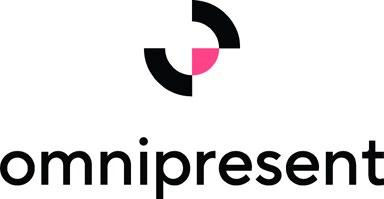
Paycom (NYSE:PAYC) offers cloud-based human capital management software to help businesses streamline employment processes, from recruitment to retirement. With a robust suite of products including payroll, time and labor management.

Designing better ways to work by providing cutting-edge products and exceptional experiences within HR, Talent, Time Management, Benefits and Payroll.

Aimed Alliance is a non-profit organization that seeks to protect and enhance the rights of health care consumers and providers.
Paychex, Inc. (Nasdaq: PAYX) is a leading provider of integrated human capital management software solutions for human resources, payroll, benefits, and insurance services.

LEARN MORE LEARN MORE LEARN MORE LEARN MORE
PARTNER WITH US
LEARN MORE
VIRTUAL EVENTS
WEBCASTS
WEBCASTS
What Does Your Workforce Really Want?
VIRTUAL EVENTS & HR.COM WEBCASTS UPCOMING www.hr.com/upcoming_webcasts www.hr.com/virtualconferences View our Upcoming Webcasts Schedule and Register Today! View our Upcoming Virtual Conference Schedule and Register Today! Mentoring and Coaching in a Remote and Hybrid World April 5, 2023 12:00 PM - 1:00 PM ET REGISTER Unlock Your Hiring Potential: The Predictive Power of Structured Interviews April 4, 2023 1:00 PM - 2:00 PM ET REGISTER Skills vs. CVs: The Power of Skills-Based Hiring in 2023 April 19, 2023 12:00 PM - 1:00 PM ET REGISTER The Bell Mentoring Program – Connecting Talent and Building Better Careers April 5, 2023 2:00 PM - 3:00 PM ET REGISTER
Successful Talent Management Strategies From Hire to Retire April 26, 2023
Lauby:
April 13, 2023 3:00 PM - 4:00 PM ET
Unconventional Benefits With Sharlyn
The Future of Coaching and Mentoring April 5, 2023 REGISTER The Future of Payroll: New Trends and Global EORs April 20, 2023 REGISTER REGISTER REGISTER






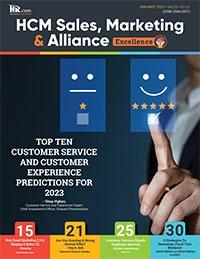






Like to submit an article? Use our online submission form or for more information go to www.hr.com/ExcellencePublications Publications 13 Targeted Publications to Reach Your Audience Informing, Educating, Enlightening and Assisting HR professionals in their personal and professional development, the Excellence series offers high-quality content through the publications!






















 Winkle
Winkle





 Rensis Likert Professor, Ross School of Business, University of Michigan Partner, The RBL Group
Rensis Likert Professor, Ross School of Business, University of Michigan Partner, The RBL Group

 Dinesh Sheth is the Founder and CEO of Green Circle Life
Dinesh Sheth is the Founder and CEO of Green Circle Life















































































